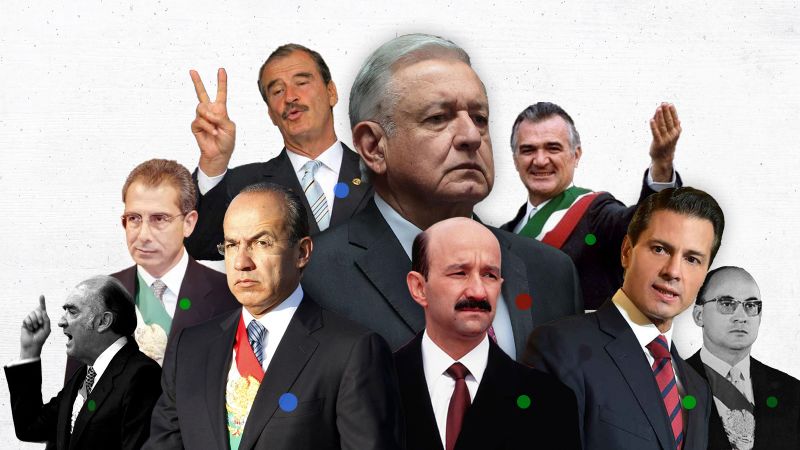Presidentes de México a través de la Historia: Un Recorrido por el Poder Ejecutivo
Mexico's history is rich and complex, deeply intertwined with the evolution of its presidency. From the tumultuous years following independence to the modern era, the office of the President of Mexico has witnessed profound changes, reflecting the nation's political, social, and economic transformations. This article explores the key figures who have shaped Mexico's destiny as its presidents, offering a chronological overview and highlighting significant milestones.
La Época Independiente y el Primer Siglo (1821-1910)
The early years of Mexican independence were marked by instability and power struggles. The first President, Agustín de Iturbide, declared himself Emperor, a short-lived reign that ended with his overthrow. This period saw a rapid succession of presidents, often characterized by:
- Intense political rivalries: Frequent coups and counter-coups disrupted governance.
- Economic instability: The young nation struggled to establish a stable economy.
- Regional conflicts: Different regions vied for power and influence.
Notable figures from this era include:
- Benito Juárez: A key figure in the Reform War, Juárez championed liberal reforms and is remembered for his resistance against the French intervention. His presidency (with interruptions) significantly impacted Mexican law and governance. Learn more about his legacy on .
- Porfirio Díaz: His long dictatorship (1876-1911), while bringing relative stability and economic growth, also resulted in immense social inequality and ultimately led to the Mexican Revolution.
El Porfiriato: Auge y Caída de un Régimen
The Porfiriato, under President Díaz, witnessed significant infrastructure development, but at the cost of suppressing dissent and creating a deeply stratified society. This period is crucial to understanding the context of the subsequent revolution. Understanding the economic policies of the Porfiriato is key to comprehending modern Mexican economics. You can find more information on this topic through .
La Revolución Mexicana y sus Consecuencias (1910-1940)
The Mexican Revolution (1910-1920) was a watershed moment, fundamentally altering the political landscape. The revolutionary period saw a fragmented power structure, with various factions vying for control. Key players include:
- Francisco I. Madero: The initial leader of the revolution, his presidency was short-lived but instrumental in initiating the upheaval.
- Venustiano Carranza: A key figure in shaping the post-revolutionary constitution.
- Álvaro Obregón: A pivotal military leader who played a crucial role in consolidating power after the revolution.
- Plutarco Elías Calles: His presidency marked the beginning of the Partido Revolucionario Institucional (PRI)'s long dominance.
This era solidified the role of the presidency and the formation of the modern Mexican state, albeit through a violent and transformative period.
El Siglo XX y el PRI (1940-2000)
The PRI's long reign (with some interruptions) saw periods of economic growth, but also authoritarianism and limited political participation. While this era witnessed significant social and economic changes, the one-party system stifled political pluralism. Some notable presidents from this era include:
- Lázaro Cárdenas: Known for his land redistribution policies.
- Miguel Alemán Valdés: A pivotal figure in Mexico's post-war economic development.
- Luis Echeverría Álvarez: His presidency witnessed significant social unrest.
This period is essential to understanding the development of Mexican institutions and the ongoing political and social dynamics. Further research can be done through .
El México Moderno y la Transición Democrática (2000-Presente)
The 21st century has brought significant changes to the Mexican presidency. The defeat of the PRI in 2000 marked a turning point, ushering in an era of multi-party competition. Presidents from different parties have shaped the country's direction, including:
- Vicente Fox: The first non-PRI president in decades.
- Felipe Calderón: Faced significant challenges related to drug cartels.
- Enrique Peña Nieto: Implemented significant economic reforms.
- Andrés Manuel López Obrador: The current president, representing a significant shift in Mexican politics.
Conclusión: Un Legado Complejo
The history of Mexico's presidents reflects the nation's journey, highlighting its struggles, triumphs, and ongoing evolution. Understanding this history is crucial for comprehending the complexities of contemporary Mexican politics and society. Further research into individual presidencies and the historical context will deepen your understanding.
Call to Action: What are your thoughts on the impact of specific Mexican presidents? Share your insights in the comments below!
